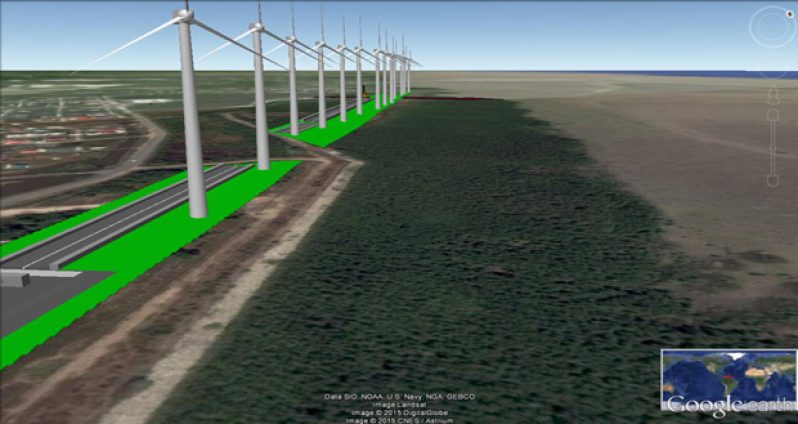THE Guyana Wind Farm Incorporated (GWF) and Guyana Power Light (GPL) will have to reach a pact on the Power Purchase Agreement (PPA) before a decision is made pertaining to the Wind Farm construction, Public Infrastructure Minister David Patterson disclosed.The government has approved the detailed examination of a proposal by Guyana Wind Farm Inc. (GWF) for a 25-megawatt wind energy plant at Hope Beach.

Minister Patterson explained that the PPA would address critical financial, commercial and technical issues relating to the development, construction, operation, maintenance and ownership of the project, including the issue of the price for which the power will be sold to GPL, and how the power is to be delivered.
When asked if there is need for tabling of a bill for this transaction in Parliament before it becomes operational, Minister Patterson said the GWF when developed will be an independent power producer which, under the current law, can only sell power to a public supplier, who in this case is GPL, if so licensed by the minister.
“Where GPL and GWF agrees to a PPA, and same is approved by the Public Utilities Commission (PUC), a licence to GWF to sell the power to GPL may be granted by the minister,” Patterson underscored.
The International Pharmaceutical Agency (IPA), one of the investors in the Hope Wind Farm Project, says the 25 megawatt facility can reduce the country’s fuel bill by US$5 million (G$1B) annually.
The project, was stalled under the previous administration, is now back on the agenda. IPA is a part of Guyana Wind-Farm Incorporated, which has once again put forward an offer which could see GoldWind of China, rated at least third in the world in the establishment of wind.
Lloyd Singh, the proprietor of IPA had long seen the benefits of the project, but said the initiative was frustrated by the PPP, which was in power for 23 years, but lost power to the multi-party APNU/AFC coalition last May.
According to Singh, by the end of the third phase, the project could provide up to 65 megawatts of electricity.
Adding that if phase two and three are implemented, he said 65 megawatts can be added to the power grid. Renewable energy, particularly wind is available 24 hours by seven days a week, throughout a year.
The Environmental Protection Agency (EPA) had determined that the project would not have a negative impact on its surroundings.
Energy is integral to development. Every developed economy in the world has been built on extensively disproportionate consumption of what seemed at the time to be abundant cheap energy – fossil fuels. It’s known, however, that emissions from industrial magnitude consumption of fossil fuels have all the while been spawning a global climate change time bomb.
Wind is clean and renewable and the cost of wind technology has been declining. According to work done by Mckinsey & Co for the Guyana Government, wind power is the third cheapest energy source behind nuclear and geothermal in the lineup of power technologies that reduce CO2 emissions.
Reports reveal that one megawatt-hour (MWh) of wind energy reduces CO2 emissions by roughly 1,200 pounds, so a single average size 1.67-MW turbine that produces over 5,000 MWh of electricity would reduce CO2 emissions by over 3,000 tonnes. (If 50 per cent of Guyana’s electrical needs were replaced by wind power it would result in a 250,000 tonnes carbon reduction which would be valued in a carbon trading system at US$6.2 million assuming a $25/tonne price). In addition unlike fossil fuel generation, operating costs are predictable once the initial capital outlays are provided for.
By Rabindra Rooplall




.jpg)










